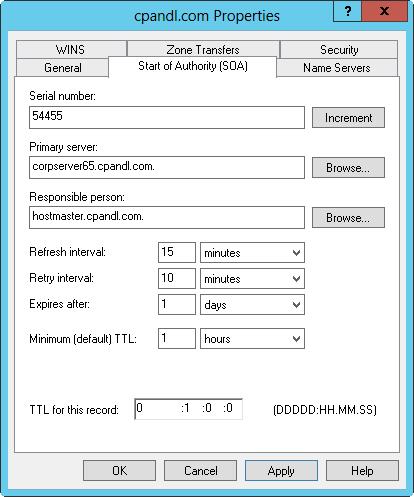Книга: Windows Server 2012 R2 Storage, Security, & Networking Pocket Consultant
Modifying the SOA record
Modifying the SOA record
An SOA record designates the authoritative name server for a zone and sets general zone properties, such as retry and refresh intervals. You can modify this information by following these steps:
1. In the DNS Manager console, press and hold or right-click the zone you want to update, and then tap or click Properties.
2. Tap or click the Start Of Authority (SOA) tab, and then update the text boxes shown in Figure 9–8.

FIGURE 9–8 In the zone’s Properties dialog box, set general properties for the zone and update the SOA record.
You use the text boxes on the Start Of Authority (SOA) tab as follows:
? Serial Number A serial number that indicates the version of the DNS database files. The number is updated automatically whenever you make changes to zone files. You can also update the number manually. Secondary servers use this number to determine whether the zone’s DNS records have changed. If the primary server’s serial number is larger than the secondary server’s serial number, the records have changed, and the secondary server can request the DNS records for the zone. You can also configure DNS to notify secondary servers of changes (which might speed up the update process).
? Primary Server The FQDN for the name server followed by a period. The period is used to terminate the name and ensure that the domain information isn’t appended to the entry.
? Responsible Person The email address of the person in charge of the domain. The default entry is hostmaster followed by a period followed by your domain name, meaning hostmaster@your_domain.com. If you change this entry, substitute a period in place of the @ symbol in the email address and terminate the address with a period.
? Refresh Interval The interval at which a secondary server checks for zone updates. The default value is 15 minutes. You reduce network traffic by increasing this value. However, keep in mind that if the interval is set to 60 minutes, NS record changes might not be propagated to a secondary server for up to an hour.
? Retry Interval The time the secondary server waits after a failure to download the zone database. If the interval is set to 10 minutes and a zone database transfer fails, the secondary server waits 10 minutes before requesting the zone database once more.
? Expires After The period of time for which zone information is valid on the secondary server. If the secondary server can’t download data from a primary server within this period, the secondary server lets the data in its cache expire and stops responding to DNS queries. Setting Expires After to seven days enables the data on a secondary server to be valid for seven days.
? Minimum (Default) TTL The minimum time-to-live (TTL) value for cached records on a secondary server. The value can be set in days, hours, minutes, or seconds. When this value is reached, the secondary server causes the associated record to expire and discards it. The next request for the record needs to be sent to the primary server for resolution. Set the minimum TTL to a relatively high value, such as 24 hours, to reduce traffic on the network and increase efficiency. Keep in mind that a higher value slows down the propagation of updates through the Internet.
? TTL For This Record The TTL value for this particular SOA record. The value is set in the format Days: Hours: Minutes: Seconds and generally should be the same as the minimum TTL for all records.
- 4.4.4 The Dispatcher
- About the author
- Chapter 7. The state machine
- Appendix E. Other resources and links
- Example NAT machine in theory
- The final stage of our NAT machine
- Compiling the user-land applications
- The conntrack entries
- Untracked connections and the raw table
- Basics of the iptables command
- Other debugging tools
- Setting up user specified chains in the filter table




